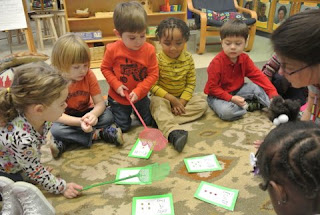Learning
about los números is very important.
It serves as a foundation for young learners’ first steps toward becoming budding
mathematicians. In our Early Childhood program, math learning is includes counting, number recognition, and one-to-one correspondence. In an attempt to
foster their academic development, these skills have also been integrated with
their Spanish language experience.
To
reinforce their number skills, the students were provided with many fun activities during their Spanish
class. We first read many books that helped introduce numerals 1 through 10. After the reading aloud, entertaining games of los matamoscas (the fly swatters) were
played using flashcards for numbers 1 through 5 and eventually adding 6 through
10. This is certainly one of our youngest learners’ favorite games.
Another
activity that was enjoyed by all was playing with unifix cubes. Each student
was provided with five cubes at first and later another five were added. A
number was called out in Spanish and then they would show the amount of cubes
that represented the number. Everyone did an amazing job connecting the verbal
to the numerical representation.
To help
reinforce the previous learning and introduce numerals 6 thru 10, we used the
SmartBoard and played an online interactive activity. Here’s the link. Go ahead
and give it a try!
OnlineFreeSpanish:
After
working on Spanish numeracy skills, the students were introduced to patterns, a
basic component of mathematical and organizational thinking. We first read Susan Ring's book, Veo patrones / I See Patterns. This was a great introductory
book for this mathematical concept. A discussion followed the read aloud and using colored unifix cubes, samples of
simple AB patterns were created for the young learners to see. Afterward, each
student was provided with a handful of cubes and invited to create their own AB
pattern. Remarkable work! We also connected the new learning to our previous
lessons on colors and the students were encouraged to name their pattern by
color. Remarkable work indeed!!
Some
friends became very confident in their ability and produced complex patterns
such as AAB and ABC.
Stay
tuned as I continue to provide challenging activities to enhance learning the
basics of mathematical thinking in a second language in our young learners.










No comments:
Post a Comment